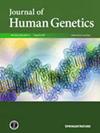与PFIC4相关的错义TJP2变异的报告,具有明显的表型变异性:重点关注蛋白质水平上的结构影响。
IF 2.5
3区 生物学
Q2 GENETICS & HEREDITY
引用次数: 0
摘要
PFIC4是一种不能根据临床和生化结果诊断的慢性肝病,其演变不可预测。在这里,我们报告了三个近亲家庭的9名儿童患有肝内胆汁淤积症并低ggt活性。选择三个先证者进行基因检测。进行了计算机分析,以评估鉴定的变异的功能影响,以及发生在蛋白质高度保守位置的变异。同时进行密切的临床监测。靶向ngs测序排除了PFIC1和PFIC2的诊断。随后,WES通过鉴定TJP2纯合子变异p. Gly532Arg,建立了三个家族的PFIC4诊断,并根据生物分子建模和模拟分析预测其结构损伤,归类为可能致病。对发生在PDZ结构域高度保守残基上的90个非单核苷酸多态性进行了深入的计算机分析,发现其中14个似乎与临床实践有关。临床表现为明显的表型变异性。总之,我们的研究描述了一种纯合子错义pfic4相关变异,并强调了这类变异的致病能力。临床评价提供了密切监测对预防肝功能衰竭的重要性,并阐明了PFIC4的意外病程。本文章由计算机程序翻译,如有差异,请以英文原文为准。

Report of a missense TJP2 variant associated to PFIC4 with a pronounced phenotypic variability: Focus on the structural effects on the protein level
PFIC4 is a chronic liver disease which cannot be diagnosed based on clinical and biochemical findings with an unpredictable evolution. Here, we reported three consanguineous families with 9 children suffering from intrahepatic cholestasis with low GGT-activity. Three probands were chosen to undergo genetic testing. In silico analyses were conducted to assess the functional impact of the identified variant, along with variants occurring at highly conserved positions within the protein. Additionally, close clinical monitoring was carried. Targeted-NGS sequencing ruled out the diagnosis of PFIC1 and PFIC2. Subsequently, WES allowed the establishment of PFIC4 diagnosis for the three families through the identification of a homozygous TJP2 variant p. Gly532Arg classified as likely pathogenic with a structural damage predicted based on biomolecular modeling and simulation analysis. In-depth in silico analysis of 90 nsSNPs occurring in highly conserved residues in PDZ domains showed 14 ones seems to be relevant in the clinical practice. Clinically, a pronounced phenotypic variability is noted. In conclusion, our study described a homozygous missense PFIC4-related variant with a highlight on the pathogenic power of such types of variants. The clinical evaluation provided information about the importance of close monitoring to prevent liver failure and clarified the unexpected course of PFIC4.
求助全文
通过发布文献求助,成功后即可免费获取论文全文。
去求助
来源期刊

Journal of Human Genetics
生物-遗传学
CiteScore
7.20
自引率
0.00%
发文量
101
审稿时长
4-8 weeks
期刊介绍:
The Journal of Human Genetics is an international journal publishing articles on human genetics, including medical genetics and human genome analysis. It covers all aspects of human genetics, including molecular genetics, clinical genetics, behavioral genetics, immunogenetics, pharmacogenomics, population genetics, functional genomics, epigenetics, genetic counseling and gene therapy.
Articles on the following areas are especially welcome: genetic factors of monogenic and complex disorders, genome-wide association studies, genetic epidemiology, cancer genetics, personal genomics, genotype-phenotype relationships and genome diversity.
 求助内容:
求助内容: 应助结果提醒方式:
应助结果提醒方式:


